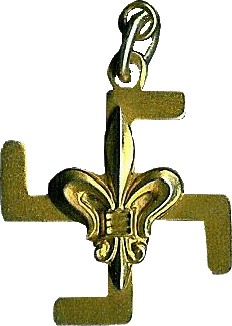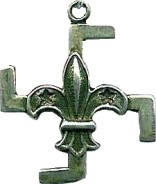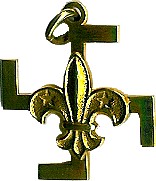 The
first Scouting use of the 'swastika' was for the Thanks Badge
introduced in 1908 and it continued to be worn in various forms until
1935. Of course, at that time it was not in the least
controversial. Rudyard Kipling, a great friend of Baden-Powell,
often used the fylfot (a term in early years) or swawtiaka as a motif on
the front cover or preface of his many books as, he said, a good luck
sign to the reader. The Kipling page on this site demonstrates the
many links between the author and the founder of Scouting and I feel
sure that B-P would have been the first to admit that his use of the
device was inspired by his friend. They first met in India, where
the design was commonplace.
The
first Scouting use of the 'swastika' was for the Thanks Badge
introduced in 1908 and it continued to be worn in various forms until
1935. Of course, at that time it was not in the least
controversial. Rudyard Kipling, a great friend of Baden-Powell,
often used the fylfot (a term in early years) or swawtiaka as a motif on
the front cover or preface of his many books as, he said, a good luck
sign to the reader. The Kipling page on this site demonstrates the
many links between the author and the founder of Scouting and I feel
sure that B-P would have been the first to admit that his use of the
device was inspired by his friend. They first met in India, where
the design was commonplace.
 B-P's
original idea was that the Scouts should make the badge themselves, and
give it to who ever they felt had done them 'a good turn'. No
permission was required from Imperial Headquarters or even the local
District Commissioner. I have seen homemade tin badges, obviously
made by Scouts, in the collection of the late Peter Berry, ex-president
of the Scout 'Badgers' Club, and illustrations for a 'pattern' made out
of a piece of wood with nails hammered in so that jeweller's gold or
silver wire could be wound round to form the badge. The badge
illustrated to the right (Kelvin Holford Collection) is made out of
silver but is not a mass-manufactured item, but looks too well crafted
to have been made by a boy.
B-P's
original idea was that the Scouts should make the badge themselves, and
give it to who ever they felt had done them 'a good turn'. No
permission was required from Imperial Headquarters or even the local
District Commissioner. I have seen homemade tin badges, obviously
made by Scouts, in the collection of the late Peter Berry, ex-president
of the Scout 'Badgers' Club, and illustrations for a 'pattern' made out
of a piece of wood with nails hammered in so that jeweller's gold or
silver wire could be wound round to form the badge. The badge
illustrated to the right (Kelvin Holford Collection) is made out of
silver but is not a mass-manufactured item, but looks too well crafted
to have been made by a boy.
 Clearly
however the standard of home-made badges did not pass muster for, in
1911, Imperial Headquarters issued a factory-made badge that could be
'officially presented' by Scout Groups without embarrassment. This
badge was just a simple 'swastika' with a small loop so that it could
be attached to clothing by means of a small safety pin. As I have
seen a gold one and read about a silver version, I can at least
'authenticate' two versions but, if the 'pattern' of later badges was
followed there would have also been a third cheaper version in 'base
metal'. The image to the left is, I regret, a sham, placed here
only to prompt memories! Using the wonders of modern graphics
programmes we have removed the fleur from a later badge to show you
exactly how the first badge would have looked. We would, as ever
be delighted to hear from you should you be able to contribute an image
of the real thing.
Clearly
however the standard of home-made badges did not pass muster for, in
1911, Imperial Headquarters issued a factory-made badge that could be
'officially presented' by Scout Groups without embarrassment. This
badge was just a simple 'swastika' with a small loop so that it could
be attached to clothing by means of a small safety pin. As I have
seen a gold one and read about a silver version, I can at least
'authenticate' two versions but, if the 'pattern' of later badges was
followed there would have also been a third cheaper version in 'base
metal'. The image to the left is, I regret, a sham, placed here
only to prompt memories! Using the wonders of modern graphics
programmes we have removed the fleur from a later badge to show you
exactly how the first badge would have looked. We would, as ever
be delighted to hear from you should you be able to contribute an image
of the real thing.
Part of reason for the rarity of this first badge is that it was in use for a relatively short time, probably less than six months. As it was merely a 'swastika', with no visual connection with the Scout Movement, it is not surprising that many of those badges would have been disregarded during the Second World War when the swastika came to be the most hated symbol in the world.
 Later
in 1911, the same basic 'swastika' with the addition of an applied very
French looking 'fleur' became available in gold, silver and base
metal. The gold was in most cases 9 carat though I have a 10 carat
example which I think was the Canadian standard. 18 carat gold is
considered too soft-wearing for most jewellery.
Later
in 1911, the same basic 'swastika' with the addition of an applied very
French looking 'fleur' became available in gold, silver and base
metal. The gold was in most cases 9 carat though I have a 10 carat
example which I think was the Canadian standard. 18 carat gold is
considered too soft-wearing for most jewellery. 
 The
different value of the metals, gold, silver and base metal, which in
later badges was replaced by brass, was perhaps meant to reflect the
level of the support given by the recipient, or more likely his or her
social standing. Britain was still a very class-ridden society in the
Edwardian era. Whilst these distinctions might have seemed a good
idea at the time the badge was introduced, it is doubtful that anybody
would really want to give or to receive the lowest value badge and
consequently they are very rare now and perversely worth more than the
gold issue! The gold example on the right, still with its pin, was
awarded to Mrs J E Wright, from 154 N.L., the abbreviation being
neccessary because of the very the limited amount of space on which to
engrave. I take N.L. to mean North London, but if any one can shed
any light on this recipient, or group, we would be pleased to include
the details here.
The
different value of the metals, gold, silver and base metal, which in
later badges was replaced by brass, was perhaps meant to reflect the
level of the support given by the recipient, or more likely his or her
social standing. Britain was still a very class-ridden society in the
Edwardian era. Whilst these distinctions might have seemed a good
idea at the time the badge was introduced, it is doubtful that anybody
would really want to give or to receive the lowest value badge and
consequently they are very rare now and perversely worth more than the
gold issue! The gold example on the right, still with its pin, was
awarded to Mrs J E Wright, from 154 N.L., the abbreviation being
neccessary because of the very the limited amount of space on which to
engrave. I take N.L. to mean North London, but if any one can shed
any light on this recipient, or group, we would be pleased to include
the details here.
Very shortly afterwards the same badges were re-issued but with the 'fleur' being cast into the fylfot and not superimposed i.e. a one piece casting.
World Scout Historian Piet Kroonenburg in a companion article to this, on these Scouting Milestones, The Evolution of the World Scout Emblem, points out that the French Scout Association had asked the International Conference in 1922 to rule that the use of the words 'Fleur' and 'Fleur de Lys' be outlawed in connection with the Scout Badge. Scouting countries were asked to call the badge by another Baden-Powell term for it, that of 'arrowhead', because many French people saw the 'fleur' as being the emblem of the deposed Bourbon Kings and as the symbol of a political party whose aims were to overthrow the Republic. Britain was a signatory at this conference, and had already decided to replace the lily design.
It was in 1920's that the 'French looking fleur' was replaced by the 1909 'Registered Design' with the two five-pointed stars in the wings. The whole purpose of the Registered Design was to provide a unique emblem that could not be copied by others for commercial gain. The French Fleur de Lys was clearly a very ancient heraldic device and neither it nor the swastika could be protected as separate individual designs, but by placing one on the other it was thought sufficiently different to be separately registered. Its design number, as far as I can discern from the example above, is 556596. The stand alone 'fleur' or 'arrowhead' known worldwide as the badge of Scouting could only be protected by law if it was unique to Scouting. This was done by the addition of the two five-pointed stars, one in each side leaf of the 'fleur'. Each of the ten points symbolises one of the ten Scout Laws (in 1908 there were only nine Scout Laws). It was this unique combination of stars applied to an ancient symbol which enabled it to be copyrighted. The new 'registered design' fleur was at first superimposed on to the arms of the fylfot, and later in 1930 once again the same design was achieved with a single casting.


